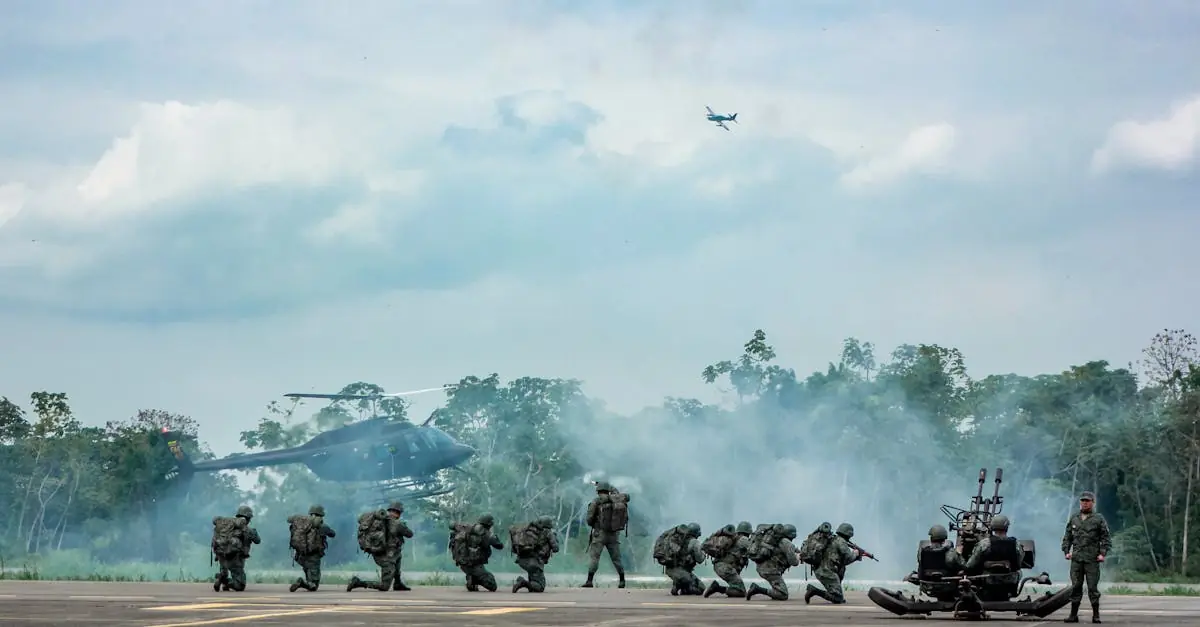When it comes to fitness, few things pack a punch quite like military training. It’s not just about lifting weights or running laps; it’s a full-throttle, sweat-drenched experience designed to push limits and build resilience. Imagine getting fit while channeling your inner soldier—minus the camouflage, of course.
Table of Contents
ToggleOverview of Military Fitness Training
Military fitness training emphasizes high-intensity workouts designed to enhance physical performance and mental toughness. The approach integrates various exercises aimed at improving strength, endurance, agility, and flexibility.
Definition and Purpose
Military fitness training refers to a rigorous exercise regimen tailored for military personnel. Its primary purpose involves building physical readiness for duty and war. This training program combines strength training, combat drills, cardiovascular conditioning, and obstacle courses. Participants develop not only physical capabilities but also mental resilience. The training fosters teamwork, discipline, and leadership skills, establishing a lifestyle of peak performance.
Historical Context
Military fitness training has roots dating back to ancient civilizations. Early military training focused on endurance and combat readiness, with exercises linked to weapon handling and battlefield tactics. Over time, the emphasis shifted towards structured fitness regimens during the 19th and 20th centuries. In World War I, training became more systematic, incorporating calisthenics and obstacle courses. The advent of modern warfare introduced the need for specialized conditioning, leading to the development of diverse training programs. Today, many military organizations worldwide adopt scientifically-backed approaches to optimize training effectiveness and soldier readiness.
Types of Military Fitness Training
Military fitness training includes various methods tailored to enhance physical performance. It focuses on both foundational and specialized regimens.
Basic Training Regimens
Basic training regimens emphasize essential physical skills necessary for combat readiness. These programs usually incorporate calisthenics, running, and basic strength exercises. Participants often engage in push-ups, sit-ups, and pull-ups to build strength and endurance. Daily physical training sessions increase progressively in intensity, fostering resilience among recruits. Standard drills also include long-distance runs to improve cardiovascular fitness. Soldiers develop teamwork and discipline through group exercises and shared challenges.
Specialized Training Programs
Specialized training programs address the unique demands of specific military roles. These courses may focus on advanced combat techniques, survival skills, or tactical operations. Programs often include obstacle courses designed to build agility and coordination. Elite forces might participate in rigorous underwater training, emphasizing breath control and endurance. Individual responsibilities demand specialized knowledge in areas like marksmanship, piloting, or engineering. Many military organizations implement high-intensity interval training to enhance performance under stress. Each specialized program aims to cultivate the skills necessary for success in various environments.
Benefits of Military Fitness Training
Military fitness training offers numerous advantages for participants. These benefits encompass both physical health improvements and psychological resilience.
Physical Health Improvements
Enhanced cardiovascular health marks a primary benefit of military fitness training. Participants engage in high-intensity workouts that boost heart and lung capacity. Strength gains also occur through resistance training, which builds muscle and increases overall functional fitness. Improved flexibility associated with dynamic exercises promotes better movement and reduces injury risks. Significant weight management can result as well, helping maintain a healthy body composition. Regular participation in military-style workouts cultivates overall health, ensuring individuals stay fit and prepared for various challenges.
Psychological Resilience
Building psychological resilience stands as another critical advantage of military fitness training. Participants develop mental toughness while facing intense physical challenges. Increased self-discipline emerges as individuals commit to rigorous routines, enhancing their ability to overcome obstacles. Stress management becomes easier, with training sessions acting as outlets for stress relief. Improved teamwork skills foster camaraderie among participants, reinforcing collective support in challenging situations. Strengthening confidence through achievement during workouts empowers individuals in personal and professional arenas. Cultivating such resilience proves vital for dealing with life’s pressures and uncertainties.
Key Components of Military Fitness Training
Military fitness training integrates diverse components that cultivate overall physical performance. These key aspects focus on building strength, endurance, and agility, preparing personnel for various challenges.
Strength and Conditioning
Strength and conditioning represent a critical element of military fitness training. Bodyweight exercises like push-ups, pull-ups, and squats enhance functional strength. Resistance training increases muscular endurance and power. Higher intensity workouts, including circuit training, improve physical capacity effectively. Military personnel follow structured regimens that incorporate weights and body mechanics, ensuring optimal performance in combat scenarios. Proper conditioning positively impacts injury prevention, aiding soldiers in sustaining their training programs over time.
Endurance and Agility
Endurance and agility training form the backbone of military fitness regimens. Running drills, stair climbing, and rucksack marches increase cardiovascular stamina and lung capacity significantly. High-intensity interval training also develops both endurance and recovery. Agility exercises, such as shuttle runs and agility ladder drills, sharpen quickness, coordination, and balance. These skills enable troops to adapt swiftly to unpredictable environments while maintaining mission readiness. Cultivating endurance combined with agility equips soldiers with the necessary tools to excel in diverse operational contexts.
Challenges and Considerations
Military fitness training presents unique challenges and considerations that participants must navigate. Adapting to high-intensity activities can strain both body and mind, underscoring the need for awareness of potential injuries.
Common Injuries and Prevention
Common injuries in military fitness training include sprains, strains, and stress fractures. These injuries often result from inadequate warm-ups or improper techniques. Participants must prioritize proper footwear and appropriate exercise techniques, which significantly reduce the risk of injury. Stretching before workouts prepares muscles for activity, while gradual progression in intensity helps avoid overexertion. Regular recovery days also contribute to injury prevention by allowing the body to heal. Through awareness and proactive measures, individuals can maintain optimal physical health during training.
Mental Toughness and Discipline
Mental toughness serves as a cornerstone of military fitness training. Individuals develop resilience through facing physical challenges and overcoming obstacles. Discipline plays a crucial role in maintaining consistent training schedules and pushing through discomfort. Setting clear goals and tracking progress fosters motivation and commitment. Team dynamics enhance accountability and provide support, further strengthening mental fortitude. Engaging in mindfulness practices can improve focus and stress management, equipping participants to face life’s unpredictable challenges effectively. This combination ultimately cultivates a mindset geared toward success and perseverance.
Military fitness training offers a unique and transformative approach to physical conditioning. By integrating high-intensity workouts with mental resilience and teamwork, it equips individuals with the tools needed to excel in various challenges. The blend of strength training, endurance drills, and specialized programs not only enhances physical capabilities but also fosters a disciplined mindset.
Embracing this rigorous training can lead to significant improvements in both health and psychological well-being. Participants often find themselves better prepared to tackle life’s obstacles with confidence and determination. Whether one seeks to enhance personal fitness or cultivate a soldier’s discipline, military fitness training serves as an effective pathway toward achieving those goals.




